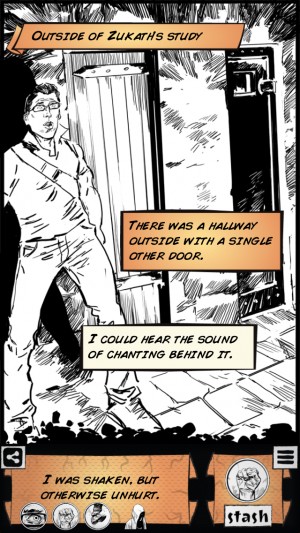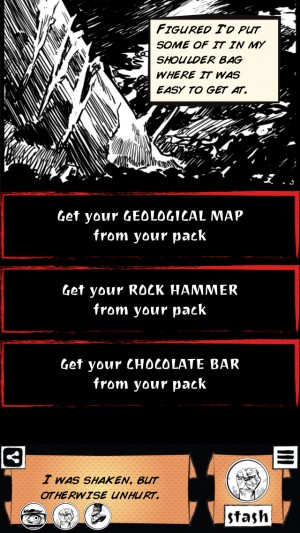 If there’s one thing, above all else, that you should take away from The Doom Beneath ($1.99), it’s that you shouldn’t run away from bears. Stand your ground, play dead, or fight back even, but if you run away from a bear, there’s a strong chance it will give chase and you’ll end up falling into a subterranean cavern filled with cultists and Lovecraftian horrors. If the worst happens and you do fall into such a cavern, you should then play dead. It’s good rehearsal for what’s ahead, I promise.
If there’s one thing, above all else, that you should take away from The Doom Beneath ($1.99), it’s that you shouldn’t run away from bears. Stand your ground, play dead, or fight back even, but if you run away from a bear, there’s a strong chance it will give chase and you’ll end up falling into a subterranean cavern filled with cultists and Lovecraftian horrors. If the worst happens and you do fall into such a cavern, you should then play dead. It’s good rehearsal for what’s ahead, I promise.
The Doom Beneath is developer Robot Monster’s second effort. Like the developer’s first release, This Is Not A Test ($1.99), The Doom Beneath is a gamebook made in the style of a graphic novel as opposed to the heavy text-based approach most others in the genre use. It’s extremely eye-catching, though it does mean there’s a lot less text to convey the story with. The theme of the last book centered around surviving a nuclear apocalypse. This time around, you’re dealing with a considerably less modern threat: cultists, demons, and elder gods. Armed with whatever few skills you pick at the beginning and any objects you can grab along the way, you have to try to survive your accidental encounter with these horrific creatures.
 The gameplay primarily consists of reading and making fairly frequent choices. The choices you have open to you will depend on the skills you selected, the items you’ve picked up, and the characters you’ve met. While there’s a little wiggle room in the form of multiple solutions to some of the dangers you’ll find yourself in, you’ll still find yourself dying a lot until you can find one of the correct sequences to win. The game also features turn-based battles from time to time, though it’s very opaque about how they’re resolved. Presumably there is some dice-rolling happening behind the scenes, but since you can’t see any of it, making selections in these battles feels more like a matter of luck than anything else. You have the option to just skip to the results, and I found myself doing that quite often after the first few fights.
The gameplay primarily consists of reading and making fairly frequent choices. The choices you have open to you will depend on the skills you selected, the items you’ve picked up, and the characters you’ve met. While there’s a little wiggle room in the form of multiple solutions to some of the dangers you’ll find yourself in, you’ll still find yourself dying a lot until you can find one of the correct sequences to win. The game also features turn-based battles from time to time, though it’s very opaque about how they’re resolved. Presumably there is some dice-rolling happening behind the scenes, but since you can’t see any of it, making selections in these battles feels more like a matter of luck than anything else. You have the option to just skip to the results, and I found myself doing that quite often after the first few fights.
Apart from those unlucky bounces, the game isn’t too hard to figure out once you’ve made a few attempts. At least in my opinion, it’s a lot more forgiving than This Is Not A Test, though there are certainly plenty of interesting ways to die. Unfortunately, it also feels more confined than the previous game. Robot Monster did a great job infusing their first game with a sort of false freedom that made it feel like you had lots of possibilities. The Doom Beneath is limited to the underground areas, and it feels a lot smaller as a result. It also lacks the unusual flavor of the previous title. There are plenty of horror-house/dungeon gamebooks out there, and apart from its fantastic presentation, The Doom Beneath doesn’t do much with its narrative to separate itself from the pack.
As long as you keep that in mind before going in, you’ll probably enjoy The Doom Beneath. Having well-drawn illustrations of every scene assists greatly in establishing the creepy mood, and I once again really enjoyed the replay value the skill system offers. Even after you’ve figured out how to beat the game, there are achievements and points to hunt down, so you’ll probably get a few more plays out of it if you’re interested in completing everything. I’m happy to see the game support suspend saving right out of the proverbial box this time, too. That’s a vital feature that wasn’t in the initial release of This Is Not A Test, but it’s working fine here. The game also makes good use of audio to support its atmosphere, though I do have to award some naughty points for it not obeying the device mute switch.


The strong presentation ensures that The Doom Beneath has a little something over the average gamebook, but that’s really all it has. It’s a relatively short, straightforward adventure with a very familiar theme. If the concept sounds interesting to you, or you’re a big gamebook fan looking for something with a bit more visual pop than the norm, you’ll probably get a decent value out of The Doom Beneath. It’s nicely polished and competently constructed, even if it ends up feeling a little underwhelming. Just make sure you pay attention to its moral, because little good ever came of a fool running away from a bear.